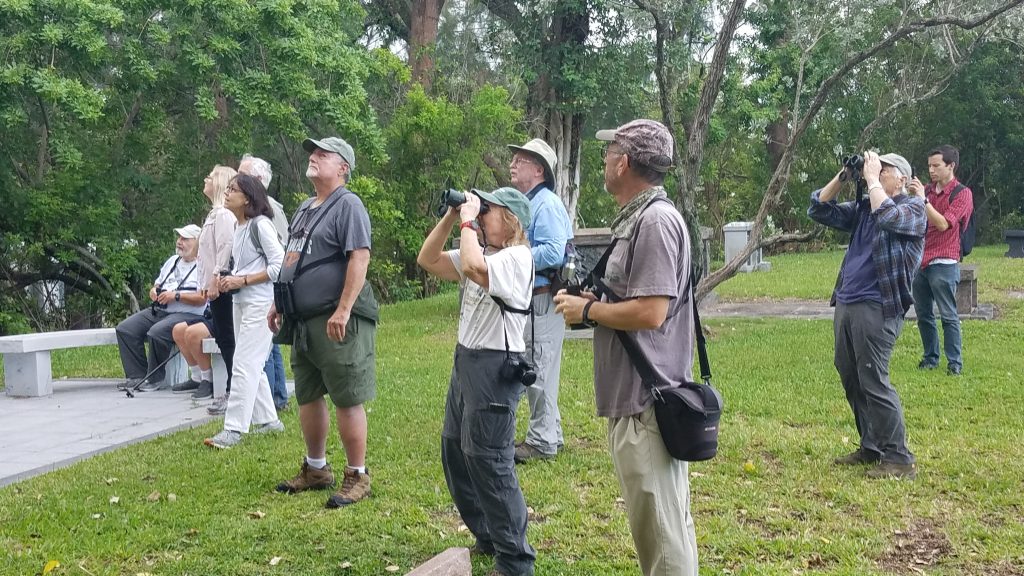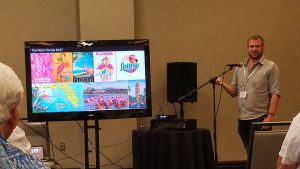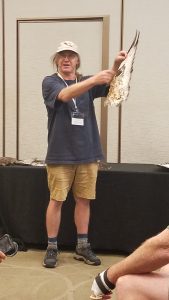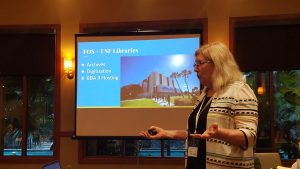Guest post from Andrew Huse, Librarian and Curator for Florida Studies at Special Collections, USF Libraries, Tampa campus.

They could tell I wasn’t one of them with a mere glance. The lack of binoculars was a dead giveaway. But I had come to Landmark Cemetery in Ft. Lauderdale on a gray drizzling morning not to watch birds, but the birders who watched them. The shared passion and camaraderie of the Florida Ornithological Society’s (FOS) membership was in evidence during the field trip, as they stalked herons, egrets, grackles, and warblers. From its inception, the FOS has been a welcoming group, with a healthy mix of academics, citizen scientists, and casual birders.

I had been invited to attend the 50th annual meeting of the Florida Ornithological Society and speak at the banquet. It seemed like a great opportunity for the FOS membership to get a better look at its own records, which had been well maintained but were not readily available in their previous home. Along with Florida History and Natural History Coordinators Erin Mattson and John Clarke, I explored the FOS archive to build a digital exhibit celebrating its fifty years that would be hosted by USF Libraries. John and I attended the conference during the weekend of October 7 to unveil the exhibit, call for collection donations, and make new friends.

We found a friendly gathering of close colleagues bound by a common passion for birds and conservation. Together, the society harnesses their passion for Florida’s bird life to document birds in the field and publish their findings in a steady stream of scholarly publications. A series of fascinating presentations followed during the afternoon, each tracing the fortunes of bird species over time in Florida’s ever-shifting landscape. I was especially pleased to see flamingo expert Dr. Steven Whitfield from Zoo Miami on the program. I had become keenly interested in the flamingo’s vague, shifting status as a Florida native; so, it was a treat to hear the story of Conchy, an injured flamingo that Whitfield helped rehabilitate. When released back into the wild, Conchy decided to stay in Florida Bay, an encouraging sign that flamingos may yet resettle in the Sunshine State.
That evening at the banquet, USF’s engagement with the society was very much in evidence. The audience got a sneak peek at the Florida Breeding Bird Atlas II, which will be hosted online by the libraries with the help and expertise of Digital Collections Curator Amanda Boczar. Just before dinner was served, John and I took the stage and gave a tag-team talk unveiling the exhibit to the membership. One attendee described it as a scrapbook lovingly created from the society’s rich records. Where one might expect only reams of scientific data in ornithological records, it is surprising how much human personality shines through the papers, supplied in abundance by some of the giants of the birding world. I took pleasure in watching faces in the audience light up at the visuals of the exhibit, such as the sight of an old friend or favorite bird. John and I received very positive feedback after our talk as the conference wound down.

It is deeply gratifying to watch the USF/FOS partnership take wing so readily in its first year, which illustrates how the pairing has been so natural. In that span, the records of the Florida Ornithological Society have been relocated to Special Collections, included in its finding aids, curated in its online exhibits, and scanned and made freely available in the libraries’ digital collections. The anticipated publication of the new Florida Breeding Bird Atlas will make the research of the FOS more accessible than ever before and demonstrates the commitment of the USF Libraries to the FLENH initiative championed by Dean Todd Chavez. For me, the most surprising part of the conference was how much I enjoyed it all, from the field trips to the scholarly papers. By the end of the conference, I was not only a steward of the society’s materials and a member of its records committee but also the latest member to join.
- For the FOS 50th anniversary exhibit, click here.
- For more about the flamingo’s status as a Florida species, click here.
- To see the finding aid for the FOS records, click here.